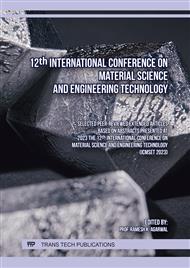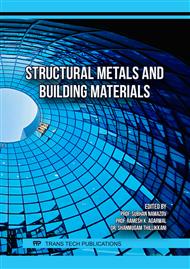p.55
p.63
p.73
p.81
p.93
p.103
p.111
p.117
p.125
Effect of Recycled Waste PET Bottle Fibers on Mechanical Properties of Geopolymer Mixtures Containing Crushed Waste Glass Sands
Abstract:
This research focused on evaluating geopolymer mixture made of ASTM class F fly ash (FFA), ground granulated blast furnace slag (GGBFS), plastic fibers obtained from recycled waste pet bottles, and crushed waste glass bottle sand (WGS) from household waste. A total of 9 mixtures were designed: 3 mixtures with long fibers (5% of aggregate weight) and without WGS, 3 mixtures with shorter non-twisted fibers (2% of aggregate weight) and WGS, and 3 mixtures with shorter twisted fibers (2% of aggregate weight) and WGS. All geopolymer mixtures contained GGBFS, FFA, WGS, plastic fibers, and 10 M of alkali-activated solution. Mechanical properties of geopolymer mixtures were evaluated at 7, 14, and 28 days. Test results indicated that PET fiber-reinforced geopolymer mixtures have lower compressive strength than non-reinforced ones. The increased length of PET fiber and extended air-curing time also decrease compressive strength. Increasing WGS content generally tends to decrease the compressive strength, but 15% replacement shows improvement compared to the reference mixture. Adding PET fibers to the geopolymer mixtures significantly increases flexural strength due to better crack resistance and good strain-hardening effect. Non-twisted fibers concrete’s flexural strength was noticeably higher than that of twisted one, while the length of fibers did not have an impact. The introduction of fibers does not increase ultimate tensile strength. However, the strain coefficient was substantially increased. Non-twisted fibers geopolymer mixtures performed better than twisted ones in terms of tension resistance. The geopolymer mixture with 30% WGS showed the highest results.
Info:
Periodical:
Pages:
117-123
Citation:
Online since:
April 2024
Price:
Сopyright:
© 2024 Trans Tech Publications Ltd. All Rights Reserved
Share:
Citation:



